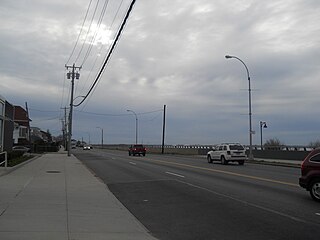The Women’s Industrial Service League, Inc. was organized on October 8, 1931, with 14 members, under the leadership of Eleanor Hull. Many women had come from the South of the United States seeking a better life through jobs and education. Many of these women became domestic employees. The organization was set up so that young women in the Far Rockaway area of Queens would have a place to get counseling, sleeping accommodations, friendship and love. Hull was the president of the organization from 1931 to 1940. Originally known as the Working Girls Cooperative League the organization was incorporated in 1934.

Far Rockaway is a neighborhood on the Rockaway Peninsula in the New York City borough of Queens in the United States. It is the easternmost section of the Rockaways. The neighborhood extends from Beach 32nd Street east to the Nassau County line. The neighborhood is part of Queens Community Board 14.

Queens is the easternmost of the five boroughs of New York City. It is the largest borough geographically and is adjacent to the borough of Brooklyn at the southwestern end of Long Island. To its east is Nassau County. Queens also shares water borders with the boroughs of Manhattan and the Bronx. Coterminous with Queens County since 1899, the borough of Queens is the second largest in population, with an estimated 2,358,582 residents in 2017, approximately 48% of them foreign-born. Queens County also is the second most populous county in the U.S. state of New York, behind Brooklyn, which is coterminous with Kings County. Queens is the fourth most densely populated county among New York City's boroughs, as well as in the United States. If each of New York City's boroughs were an independent city, Queens would be the nation's fourth most populous, after Los Angeles, Chicago, and Brooklyn. Queens is the most ethnically diverse urban area in the world.
The Women’s Industrial Service League, Inc. purchased an indoor facility in 1936 to provide housing accommodations for detached women. The dwelling has a playground for children and an indoor Assembly area. The building is located at 1428 Beach Channel Drive in Far Rockaway.

Beach Channel Drive is the main thoroughfare of the Rockaway Peninsula in the New York City borough of Queens. It extends from the Nassau County border at Inwood westward, to the Marine Parkway–Gil Hodges Memorial Bridge at the end of Jacob Riis Park. From Hammels westward, it follows along Jamaica Bay on the northern side of the peninsula.
Emily Brown was the second president of the Women’s Industrial Service League and was instrumental in two major developments in Far Rockaway history. The high incidents of Tuberculosis in the Black community led to the creation of a chest x-ray program which was the spark that led to the creation of the Council for Health and Welfare. The Council for Health and Welfare began the fight for adequate housing believing that the risk of catching Tuberculosis was increased by the bad living conditions of the poor. The battle for better housing was culminated in the building of the Redfern Housing Projects.

X-rays make up X-radiation, a form of electromagnetic radiation. Most X-rays have a wavelength ranging from 0.01 to 10 nanometers, corresponding to frequencies in the range 30 petahertz to 30 exahertz (3×1016 Hz to 3×1019 Hz) and energies in the range 100 eV to 100 keV. X-ray wavelengths are shorter than those of UV rays and typically longer than those of gamma rays. In many languages, X-radiation is referred to with terms meaning Röntgen radiation, after the German scientist Wilhelm Röntgen who discovered these on November 8, 1895, who usually is credited as its discoverer, and who named it X-radiation to signify an unknown type of radiation. Spelling of X-ray(s) in the English language includes the variants x-ray(s), xray(s), and X ray(s).

Tuberculosis (TB) is an infectious disease usually caused by Mycobacterium tuberculosis (MTB) bacteria. Tuberculosis generally affects the lungs, but can also affect other parts of the body. Most infections do not have symptoms, in which case it is known as latent tuberculosis. About 10% of latent infections progress to active disease which, if left untreated, kills about half of those affected. The classic symptoms of active TB are a chronic cough with blood-containing sputum, fever, night sweats, and weight loss. It was historically called "consumption" due to the weight loss. Infection of other organs can cause a wide range of symptoms.
The Women’s Industrial Service League, Inc. has provided young people with a place to understand and evaluate all of the options that life provides for them. The league has been successful in providing scholarships and friendships that enhance and encourage young men and women. The annual Scholarship and Awards Luncheon began in 2005. The organization has also provided members with the chance to interact with guest speakers from different occupational backgrounds, sponsored seminars on entrepreneurship, resume writing, and participated in Black College Fairs.
Historically black colleges and universities (HBCUs) are institutions of higher education in the United States that were established before the Civil Rights Act of 1964 with the intention of primarily serving the African-American community. This was because the overwhelming majority of predominantly white institutions of higher-learning disqualified African Americans from enrollment during segregation. From the time of slavery in the 19th century through to the second half of the 20th century, majority schools in the Southern United States prohibited all African Americans from attending, while historic schools in other parts of the country regularly employed quotas to limit admissions of blacks.
A Youth Club was re-established within the organization in 1992. This was created by Women Industrial Service League, Inc. members Frances Shackelford-Howell and Yolanda Walker to help young people starting from the age of adolescence.












